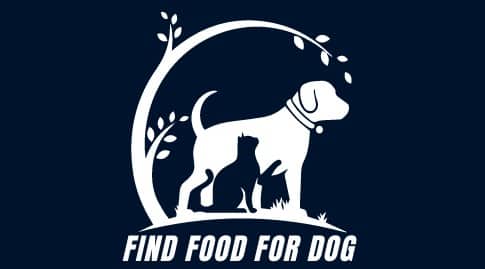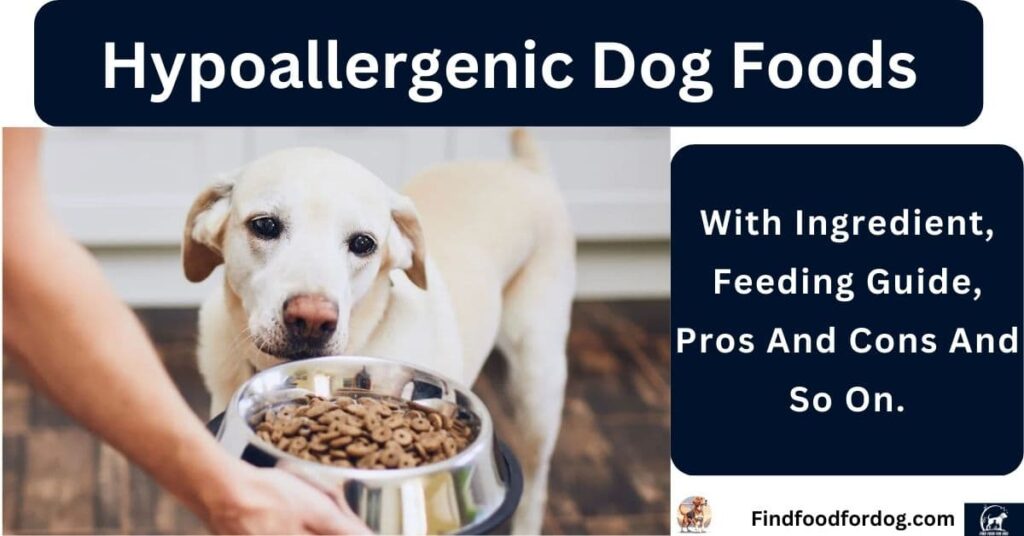The best hypoallergenic dry dog food often contain limited ingredients and novel proteins. Brands like Blue Buffalo, Wellness, and Hill's Prescription Diet are highly recommended.
Finding the right hypoallergenic dry dog food is crucial for dogs with food sensitivities or allergies. These specially formulated diets help alleviate symptoms such as itching, gastrointestinal distress, and skin irritations. Selecting a product with high-quality ingredients and limited fillers can make a significant difference in your dog's health.
Always consult your veterinarian before making dietary changes. A tailored diet not only improves your pet's well-being but also enhances their overall quality of life. Prioritizing hypoallergenic options ensures your furry friend stays happy and healthy without discomfort.

Table of Contents
ToggleIntroduction To Hypoallergenic Dry Dog Food
Hypoallergenic dry dog food is designed for dogs with allergies. Many dogs suffer from food sensitivities. This type of food helps reduce allergic reactions. It uses limited ingredients. This makes it easier for dogs to digest.
Why Hypoallergenic Food Matters For Dogs
Feeding your dog hypoallergenic food can improve their health. Here are some benefits:
- Reduced Allergies: Less chance of allergic reactions.
- Better Digestion: Easier on the stomach.
- Healthier Skin: Reduces itching and rashes.
- Improved Energy: Dogs feel more lively and active.
Common Allergens In Traditional Dog Foods
Many traditional dog foods contain common allergens. These can trigger reactions in sensitive dogs. Here are some usual culprits:
| Allergen | Symptoms |
|---|---|
| Beef | Itching, digestive issues |
| Dairy | Diarrhea, vomiting |
| Chicken | Skin irritation, ear infections |
| Wheat | Gas, bloating |
| Eggs | Itchy skin, swelling |
Choosing hypoallergenic food can help prevent these issues. It provides a tailored diet for your dog’s needs.
Identifying Food Sensitivities In Dogs
Food sensitivities in dogs can cause many health issues. Recognizing these issues early helps your dog feel better. Hypoallergenic dog food may provide relief. Understanding the signs and diagnosis process is essential.
Signs Your Dog May Need Hypoallergenic Food
Watch for these common signs:
- Itchy skin: Excessive scratching or biting.
- Red or inflamed skin: Rashes or hot spots.
- Gastrointestinal issues: Vomiting or diarrhea.
- Ear infections: Frequent ear problems.
- Hair loss: Patches of missing fur.
Dogs may show one or multiple signs. Observe their behavior closely. Changes in diet often help improve their condition.
The Process Of Diagnosing Canine Allergies
Diagnosing food allergies in dogs involves several steps:
- Consult your veterinarian: Schedule an appointment.
- Provide a history: Share your dog's symptoms and diet.
- Food elimination trial: Remove potential allergens for several weeks.
- Reintroduction phase: Gradually add foods back to identify triggers.
- Allergy testing: Consider blood tests if needed.
Each step helps narrow down potential food sensitivities. Early detection leads to better health outcomes for your dog.
Key Ingredients In Hypoallergenic Dog Food
Choosing the right hypoallergenic dog food is crucial for dogs with sensitivities. Understanding the key ingredients helps you make an informed choice. These foods often focus on specific proteins, carbohydrates, and fats.
Novel Protein Sources
Novel protein sources are essential in hypoallergenic dog food. They reduce the risk of allergic reactions. Common novel proteins include:
- Duck
- Rabbit
- Venison
- Fish
- Quail
These proteins are less likely to trigger allergies. They provide essential amino acids for your dog's health.
The Role Of Carbohydrates And Fats
Carbohydrates and fats play important roles in dog nutrition. They provide energy and support overall health. Here’s how they contribute:
| Component | Function |
|---|---|
| Carbohydrates | Supply energy and aid digestion. |
| Fats | Support skin health and provide essential fatty acids. |
Common carbohydrate sources include:
- Sweet potatoes
- Brown rice
- Peas
These ingredients help maintain a balanced diet. They contribute to your dog's overall well-being.

Top Rated Hypoallergenic Dry Dog Food Brands
Finding the best hypoallergenic dry dog food can improve your dog's health. Many brands offer high-quality options. These foods help dogs with allergies and sensitivities. Below, discover top-rated brands in two categories: premium options and budget-friendly alternatives.
Premium Options For Optimal Health
Premium hypoallergenic dry dog foods provide excellent nutrition. They use high-quality ingredients and avoid common allergens. Here are some top brands:
| Brand | Main Protein Source | Key Features |
|---|---|---|
| Royal Canin | Duck | Formulated for specific breeds |
| Hill's Science Diet | Salmon | Veterinarian recommended |
| Blue Buffalo | Chicken | No artificial flavors or preservatives |
Royal Canin
Hill's Science Diet
Blue Buffalo
These brands are known for their commitment to quality. They often include added vitamins and minerals. This helps maintain overall health and well-being.
Budget-friendly Alternatives
Quality hypoallergenic dry dog food doesn't have to break the bank. Here are some affordable options:
- Purina Pro Plan – Uses salmon as the main protein source.
- Wellness Simple – Features limited ingredients for easy digestion.
- Nature's Logic – Made with whole foods and no synthetic additives.
Purina Pro Plan
Wellness CORE
Nature's Recipe
These brands offer great nutrition at a lower price. They still avoid common allergens and support healthy digestion.
Choosing the right food is essential for your dog's health. Both premium and budget-friendly options can meet their needs. Focus on quality ingredients to ensure optimal health.
Specialized Diets For Different Breeds
Every dog has unique dietary needs. These needs depend on breed, size, and activity level. Choosing the right food is essential for health. Hypoallergenic dry dog food can help manage allergies. Let’s explore tailored nutrition for different breeds.
Tailored Nutrition For Small Breeds
Small breeds have specific dietary requirements. They need food that supports their energy levels. The right hypoallergenic food offers balanced nutrition. Here are key features to consider:
- High Protein Content: Small dogs require more protein for energy.
- Small Kibble Size: Easy for tiny mouths to chew.
- Rich in Omega Fatty Acids: Supports skin health and coat shine.
| Brand | Protein (%) | Fat (%) | Special Features |
|---|---|---|---|
| Brand A | 30 | 15 | Grain-free |
| Brand B | 28 | 16 | Added probiotics |
Optimal Choices For Large Breeds
Large breeds need a different approach. Their diet must support bone and joint health. A good hypoallergenic dry dog food helps maintain muscle mass. Focus on these aspects:
- Joint Support: Look for glucosamine and chondroitin.
- Controlled Calories: Prevents obesity in larger dogs.
- Balanced Nutrients: Ensures overall health and vitality.
| Brand | Protein (%) | Fat (%) | Special Features |
|---|---|---|---|
| Brand C | 25 | 12 | High fiber |
| Brand D | 27 | 14 | Calcium-rich |
Feeding Guidelines And Portion Control
Feeding your dog the right amount is crucial. Proper portion control helps maintain healthy weight. It also supports overall well-being. Follow these guidelines to keep your furry friend happy.
Determining The Right Amount
Finding the right amount of food is essential. Every dog has unique needs. Use the following factors to guide you:
- Dog's Weight: Heavier dogs need more food.
- Age: Puppies require more calories than adults.
- Breed: Different breeds have varying needs.
- Health Status: Consult your vet for special diets.
Refer to the feeding guide on your dog food packaging. This guide gives a starting point for portion sizes. Here is a simple table to help you:
| Dog Weight (lbs) | Daily Amount (cups) |
|---|---|
| 5-10 | 1/2 – 1 |
| 11-20 | 1 – 1.5 |
| 21-40 | 1.5 – 2.5 |
| 41-60 | 2.5 – 3.5 |
| 61+ | 3.5+ |
Adjusting The Diet For Activity Level
Activity level greatly affects your dog's dietary needs. Active dogs burn more calories. Here’s how to adjust their diet:
- High Activity: Increase food by 10-20%.
- Moderate Activity: Stick to the standard portion size.
- Low Activity: Reduce food by 10-20%.
Monitor your dog’s weight regularly. Adjust portions as needed. A healthy dog is a happy dog!
Transitioning To Hypoallergenic Dog Food
Switching to hypoallergenic dog food can help your pup feel better. Allergies can cause skin irritations and digestive issues. This transition requires care and attention.
Doing it right helps your dog adapt smoothly. A gradual change reduces stomach upset. Follow the steps below for a successful transition.
Step-by-step Guide To Switching Foods
- Choose the Right Hypoallergenic Food: Select a brand that suits your dog's needs. Look for ingredients that minimize allergens.
- Start Slowly: Mix a small amount of the new food with the old food.
- Increase Gradually: Every few days, increase the new food portion. Decrease the old food gradually.
- Monitor Portions: Maintain the same feeding schedule. Keep portion sizes consistent.
- Be Patient: It may take time for your dog to adjust. Some dogs adapt faster than others.
Monitoring Your Dog's Response To The New Diet
Keep a close eye on your dog during the transition. Watch for any signs of allergies. Look for these common symptoms:
- Itchy skin or paws
- Gastrointestinal upset
- Changes in energy levels
- Changes in coat condition
Take advice from Pet Expert Dr Marty
Document your observations. This information helps you track progress. If symptoms worsen, consult your veterinarian. They can suggest alternative foods or adjust the diet plan.
Supporting Your Dog's Health Beyond Diet
Feeding your dog the best hypoallergenic dry dog food is essential. Yet, health goes beyond just diet. Regular care and extra nutrition enhance your dog's well-being. Focus on holistic health for a happier, healthier pet.
Supplements For Enhanced Nutrition
Supplements can boost your dog's health. They help fill nutritional gaps. Here are some popular options:
| Supplement | Benefits |
|---|---|
| Omega-3 Fatty Acids | Supports skin and coat health |
| Probiotics | Enhances gut health and digestion |
| Glucosamine | Promotes joint health |
| Vitamins | Boosts immune function |
Consult your vet before adding any supplements. They can recommend the best options for your dog.
The Importance Of Regular Veterinary Check-ups
Regular vet visits are vital for your dog's health. These check-ups catch issues early. Here’s why they matter:
- Monitor weight and diet
- Update vaccinations
- Conduct dental checks
- Screen for parasites
- Assess overall health
Set a schedule for annual or bi-annual visits. Regular check-ups ensure your dog stays healthy and happy.
:strip_icc()/hillls-dd-canine-potato-and-duck-formula-dry-productShot_zoom-a25d7afed0874f47adb1871c06aaad0f.jpeg)
Hill's Science Diet
Frequently Asked Questions About Best Hypoallergenic Dry Dog Food
What Is Hypoallergenic Dry Dog Food?
Hypoallergenic dry dog food is specifically formulated to reduce allergic reactions in dogs. It often contains limited ingredients and alternative protein sources. This type of food helps in managing food sensitivities and allergies, promoting better digestion and overall health. Always consult your vet before making dietary changes.
How Do I Choose Hypoallergenic Dog Food?
Choosing hypoallergenic dog food requires assessing your dog's specific needs. Look for products with limited ingredients and novel protein sources. Ensure the food is free from common allergens like wheat, soy, and dairy. Consulting your veterinarian can provide tailored recommendations based on your dog's health and dietary restrictions.
Can All Dogs Eat Hypoallergenic Food?
Not all dogs require hypoallergenic food, but many can benefit from it. Dogs with food allergies or sensitivities may find relief with hypoallergenic options. Always consult your veterinarian to determine if your dog needs this specialized diet. They can help identify any specific allergens affecting your pet.
What Ingredients Should I Avoid In Dog Food?
Avoid common allergens such as wheat, corn, and soy in dog food. Additionally, steer clear of artificial preservatives and fillers. Ingredients like by-products can be low-quality and may trigger allergies. Always read labels carefully to ensure you’re choosing the best food for your dog's health.
Conclusion
Choosing the right hypoallergenic dry dog food is essential for your pet's health. It helps prevent allergies and promotes overall well-being. With various options available, consider your dog's specific needs. Prioritize high-quality ingredients and consult your vet for the best choice.
A happy, healthy dog starts with the right nutrition.














